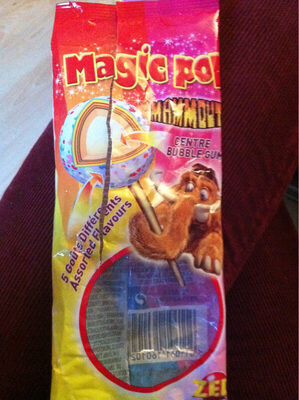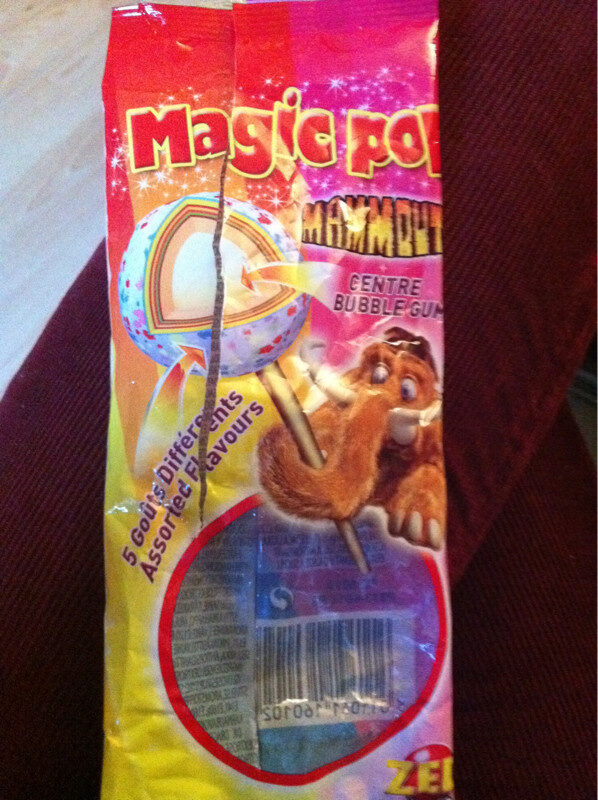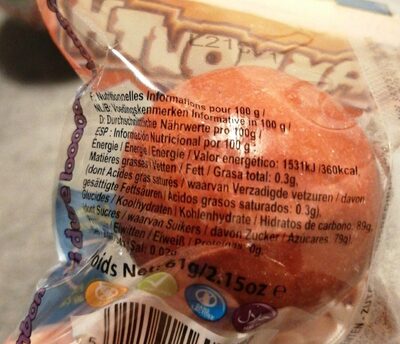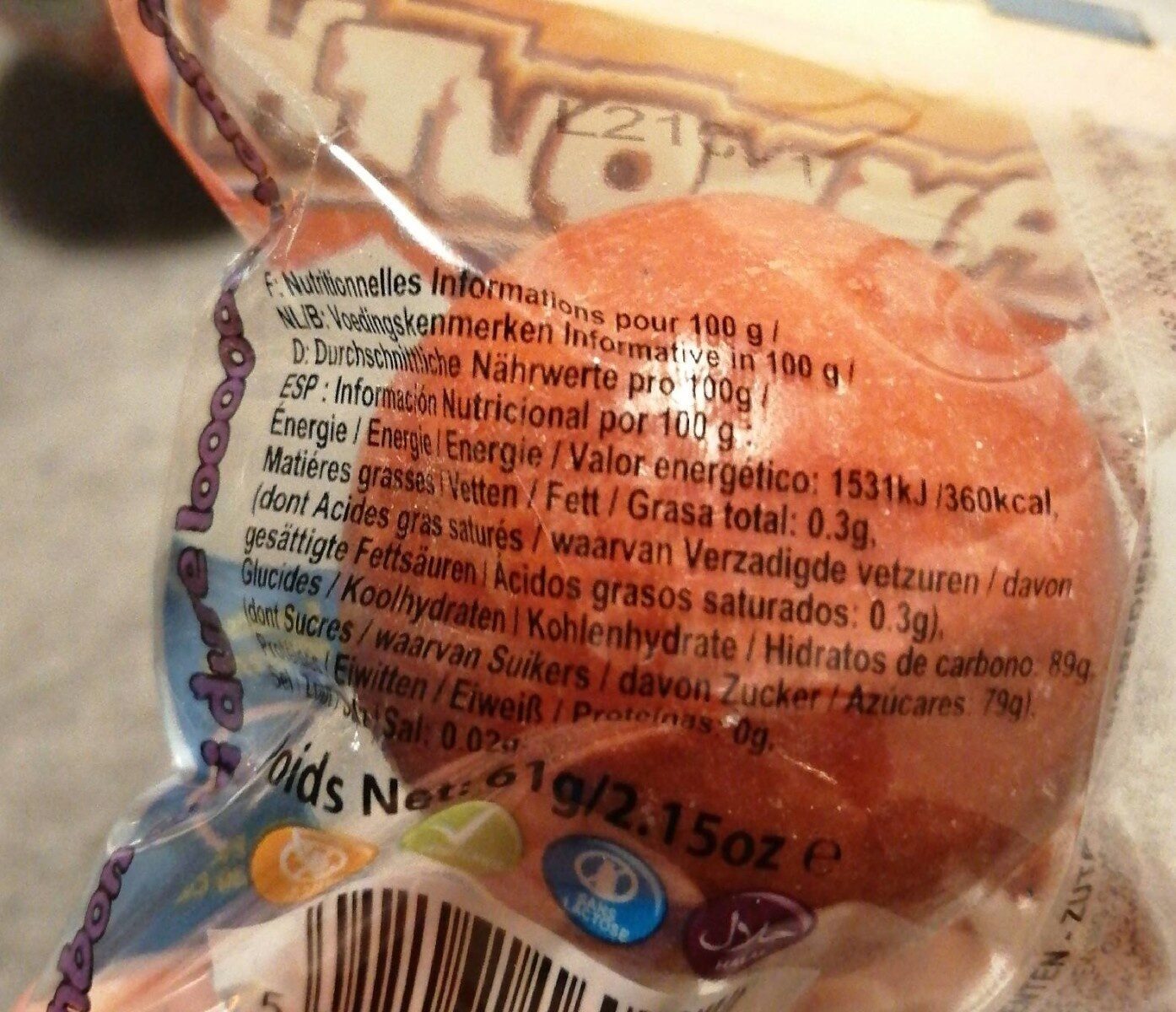Ajuda'ns a fer que la transparència alimentària sigui la norma!
Com a organització sense ànim de lucre, depenem de les vostres donacions per continuar informant els consumidors de tot el món sobre tot allò què mengen.
La revolució alimentària comença amb tu!
Magic Pop Mammouth - Zed Candy
Magic Pop Mammouth - Zed Candy
Aquesta pàgina del producte no està completa. Podeu ajudar a completar-la editant-la i afegint-hi més dades a partir de les fotos ja disponibles, o fent-ne més amb l'aplicació de androide o iPhone / iPad. Gràcies!
×
Codi de barres: 5011061160102 (EAN / EAN-13)
Marques: Zed Candy
Categories: Snacks, Aperitius dolços, Llaminadures, Caramels, en:Lollipops
Matching with your preferences
Salut
Ingredients
-
21 ingredients
: Dextrosa, azúcar, goma base, jarabe de glucosa, aromas, acido: acido citrico; agente humectante: glicenina; almidón modficado, colorantes: E133, E141, E160a, E171; negro cenoria concentrado, producto para dar brillo: cera de camauba. goma laca, antioxidante: E321.
Processament d'aliments
-
Aliments ultra processats
Elements que indiquen que el producte està al grup 4 - Aliments i begudes ultraprocessats:
- Additiu: E133 - Blau brillant FCF
- Additiu: E141 - Complexos cúprics de clorofil i clorofilines
- Additiu: E160a - Carotè
- Additiu: E171 - Diòxid de titani
- Additiu: E904 - Goma laca
- Ingredient: Color
- Ingredient: Dextrosa
- Ingredient: Aromes
- Ingredient: Glucosa
- Ingredient: Xarop de glucosa
- Ingredient: Humectant
Els productes alimentaris es classifiquen en 4 grups segons el seu grau de processament:
- Aliments no processats o mínimament processats
- Ingredients culinaris processats
- Aliments processats
- Aliments ultra processats
La determinació del grup es fa en funció de la categoria del producte i dels ingredients que conté.
Additius
-
E133 - Blau brillant FCF
Brilliant Blue FCF: Brilliant Blue FCF -Blue 1- is an organic compound classified as a triarylmethane dye and a blue azo dye, reflecting its chemical structure. Known under various commercial names, it is a colorant for foods and other substances. It is denoted by E number E133 and has a color index of 42090. It has the appearance of a blue powder. It is soluble in water, and the solution has a maximum absorption at about 628 nanometers.Origen: Wikipedia (Anglès)
-
E160a - Carotè
Carotene: The term carotene -also carotin, from the Latin carota, "carrot"- is used for many related unsaturated hydrocarbon substances having the formula C40Hx, which are synthesized by plants but in general cannot be made by animals -with the exception of some aphids and spider mites which acquired the synthesizing genes from fungi-. Carotenes are photosynthetic pigments important for photosynthesis. Carotenes contain no oxygen atoms. They absorb ultraviolet, violet, and blue light and scatter orange or red light, and -in low concentrations- yellow light. Carotenes are responsible for the orange colour of the carrot, for which this class of chemicals is named, and for the colours of many other fruits, vegetables and fungi -for example, sweet potatoes, chanterelle and orange cantaloupe melon-. Carotenes are also responsible for the orange -but not all of the yellow- colours in dry foliage. They also -in lower concentrations- impart the yellow coloration to milk-fat and butter. Omnivorous animal species which are relatively poor converters of coloured dietary carotenoids to colourless retinoids have yellowed-coloured body fat, as a result of the carotenoid retention from the vegetable portion of their diet. The typical yellow-coloured fat of humans and chickens is a result of fat storage of carotenes from their diets. Carotenes contribute to photosynthesis by transmitting the light energy they absorb to chlorophyll. They also protect plant tissues by helping to absorb the energy from singlet oxygen, an excited form of the oxygen molecule O2 which is formed during photosynthesis. β-Carotene is composed of two retinyl groups, and is broken down in the mucosa of the human small intestine by β-carotene 15‚15'-monooxygenase to retinal, a form of vitamin A. β-Carotene can be stored in the liver and body fat and converted to retinal as needed, thus making it a form of vitamin A for humans and some other mammals. The carotenes α-carotene and γ-carotene, due to their single retinyl group -β-ionone ring-, also have some vitamin A activity -though less than β-carotene-, as does the xanthophyll carotenoid β-cryptoxanthin. All other carotenoids, including lycopene, have no beta-ring and thus no vitamin A activity -although they may have antioxidant activity and thus biological activity in other ways-. Animal species differ greatly in their ability to convert retinyl -beta-ionone- containing carotenoids to retinals. Carnivores in general are poor converters of dietary ionone-containing carotenoids. Pure carnivores such as ferrets lack β-carotene 15‚15'-monooxygenase and cannot convert any carotenoids to retinals at all -resulting in carotenes not being a form of vitamin A for this species-; while cats can convert a trace of β-carotene to retinol, although the amount is totally insufficient for meeting their daily retinol needs.Origen: Wikipedia (Anglès)
-
E171 - Diòxid de titani
Titanium dioxide: Titanium dioxide, also known as titaniumIV oxide or titania, is the naturally occurring oxide of titanium, chemical formula TiO2. When used as a pigment, it is called titanium white, Pigment White 6 -PW6-, or CI 77891. Generally, it is sourced from ilmenite, rutile and anatase. It has a wide range of applications, including paint, sunscreen and food coloring. When used as a food coloring, it has E number E171. World production in 2014 exceeded 9 million metric tons. It has been estimated that titanium dioxide is used in two-thirds of all pigments, and the oxide has been valued at $13.2 billion.Origen: Wikipedia (Anglès)
-
E321 - Butilhidroxitoluè
Butylated hydroxytoluene: Butylated hydroxytoluene -BHT-, also known as dibutylhydroxytoluene, is a lipophilic organic compound, chemically a derivative of phenol, that is useful for its antioxidant properties. European and U.S. regulations allow small amounts to be used as a food additive. In addition to this use, BHT is widely used to prevent oxidation in fluids -e.g. fuel, oil- and other materials where free radicals must be controlled.Origen: Wikipedia (Anglès)
-
E330 - Acid citric
Citric acid: Citric acid is a weak organic acid that has the chemical formula C6H8O7. It occurs naturally in citrus fruits. In biochemistry, it is an intermediate in the citric acid cycle, which occurs in the metabolism of all aerobic organisms. More than a million tons of citric acid are manufactured every year. It is used widely as an acidifier, as a flavoring and chelating agent.A citrate is a derivative of citric acid; that is, the salts, esters, and the polyatomic anion found in solution. An example of the former, a salt is trisodium citrate; an ester is triethyl citrate. When part of a salt, the formula of the citrate ion is written as C6H5O3−7 or C3H5O-COO-3−3.Origen: Wikipedia (Anglès)
-
E904 - Goma laca
Shellac: Shellac is a resin secreted by the female lac bug, on trees in the forests of India and Thailand. It is processed and sold as dry flakes -pictured- and dissolved in alcohol to make liquid shellac, which is used as a brush-on colorant, food glaze and wood finish. Shellac functions as a tough natural primer, sanding sealant, tannin-blocker, odour-blocker, stain, and high-gloss varnish. Shellac was once used in electrical applications as it possesses good insulation qualities and it seals out moisture. Phonograph and 78 rpm gramophone records were made of it until they were replaced by vinyl long-playing records from the 1950s onwards. From the time it replaced oil and wax finishes in the 19th century, shellac was one of the dominant wood finishes in the western world until it was largely replaced by nitrocellulose lacquer in the 1920s and 1930s.Origen: Wikipedia (Anglès)
Anàlisi dels ingredients
-
Pot contenir oli de palma
Ingredients que poden contenir oli de palma: E160a
-
No és vegà
Ingredients no vegans: E904Alguns ingredients no s'han pogut reconèixer.
Necessitem la teva ajuda!
Podeu ajudar-nos a reconèixer més ingredients i analitzar millor la llista d'ingredients d'aquest producte i d'altres mitjançant:
- Editeu aquesta pàgina de producte per corregir les faltes d’ortografia de la llista d’ingredients i/o per eliminar els ingredients d’altres idiomes i frases que no estiguin relacionades amb els ingredients.
- Afegiu entrades, sinònims o traduccions noves a les nostres llistes multilingües d’ingredients, mètodes de processament d’ingredients i etiquetes.
Uniu-vos al canal #ingredients del nostre espai de discussió a Slack i/o apreneu sobre l'anàlisi dels ingredients en la nostra wiki, si voleu ajudar. Gràcies!
-
No és vegetarià
Ingredients no vegetarians: E904Alguns ingredients no s'han pogut reconèixer.
Necessitem la teva ajuda!
Podeu ajudar-nos a reconèixer més ingredients i analitzar millor la llista d'ingredients d'aquest producte i d'altres mitjançant:
- Editeu aquesta pàgina de producte per corregir les faltes d’ortografia de la llista d’ingredients i/o per eliminar els ingredients d’altres idiomes i frases que no estiguin relacionades amb els ingredients.
- Afegiu entrades, sinònims o traduccions noves a les nostres llistes multilingües d’ingredients, mètodes de processament d’ingredients i etiquetes.
Uniu-vos al canal #ingredients del nostre espai de discussió a Slack i/o apreneu sobre l'anàlisi dels ingredients en la nostra wiki, si voleu ajudar. Gràcies!
-
Detalls de l'anàlisi dels ingredients
Necessitem la teva ajuda!
Alguns ingredients no s'han pogut reconèixer.
Necessitem la teva ajuda!
Podeu ajudar-nos a reconèixer més ingredients i analitzar millor la llista d'ingredients d'aquest producte i d'altres mitjançant:
- Editeu aquesta pàgina de producte per corregir les faltes d’ortografia de la llista d’ingredients i/o per eliminar els ingredients d’altres idiomes i frases que no estiguin relacionades amb els ingredients.
- Afegiu entrades, sinònims o traduccions noves a les nostres llistes multilingües d’ingredients, mètodes de processament d’ingredients i etiquetes.
Uniu-vos al canal #ingredients del nostre espai de discussió a Slack i/o apreneu sobre l'anàlisi dels ingredients en la nostra wiki, si voleu ajudar. Gràcies!
: Dextrosa, azúcar, goma base, jarabe de glucosa, aromas, acido (acido citrico), agente humectante (glicenina), almidón modficado, colorantes (e133), e141, e160a, e171, negro cenoria concentrado, producto para dar brillo (cera de camauba, goma laca), antioxidante (e321)- Dextrosa -> en:dextrose - vegan: yes - vegetarian: yes - ciqual_proxy_food_code: 31016 - percent_min: 6.66666666666667 - percent_max: 100
- azúcar -> en:sugar - vegan: yes - vegetarian: yes - ciqual_proxy_food_code: 31016 - percent_min: 0 - percent_max: 50
- goma base -> es:goma-base - percent_min: 0 - percent_max: 33.3333333333333
- jarabe de glucosa -> en:glucose-syrup - vegan: yes - vegetarian: yes - ciqual_proxy_food_code: 31016 - percent_min: 0 - percent_max: 25
- aromas -> en:flavouring - vegan: maybe - vegetarian: maybe - percent_min: 0 - percent_max: 5
- acido -> en:acid - percent_min: 0 - percent_max: 5
- acido citrico -> en:e330 - vegan: yes - vegetarian: yes - percent_min: 0 - percent_max: 5
- agente humectante -> en:humectant - percent_min: 0 - percent_max: 5
- glicenina -> es:glicenina - percent_min: 0 - percent_max: 5
- almidón modficado -> es:almidon-modficado - percent_min: 0 - percent_max: 5
- colorantes -> en:colour - percent_min: 0 - percent_max: 5
- e133 -> en:e133 - vegan: yes - vegetarian: yes - percent_min: 0 - percent_max: 5
- e141 -> en:e141 - vegan: yes - vegetarian: yes - percent_min: 0 - percent_max: 5
- e160a -> en:e160a - vegan: maybe - vegetarian: maybe - from_palm_oil: maybe - percent_min: 0 - percent_max: 5
- e171 -> en:e171 - vegan: yes - vegetarian: yes - percent_min: 0 - percent_max: 5
- negro cenoria concentrado -> es:negro-cenoria-concentrado - percent_min: 0 - percent_max: 5
- producto para dar brillo -> es:producto-para-dar-brillo - percent_min: 0 - percent_max: 5
- cera de camauba -> es:cera-de-camauba - percent_min: 0 - percent_max: 5
- goma laca -> en:e904 - vegan: no - vegetarian: no - percent_min: 0 - percent_max: 2.5
- antioxidante -> en:antioxidant - percent_min: 0 - percent_max: 5
- e321 -> en:e321 - vegan: yes - vegetarian: yes - percent_min: 0 - percent_max: 5
Nutrició
-
Poca qualitat nutricional
⚠ ️Atenció: la quantitat de fruita, verdura i fruits secs no s'especifica a l'etiqueta, s'ha fet una estimació a partir de la llista d'ingredients: 0Aquest producte no es considera una beguda per al càlcul de la Nutri-Score.
Punts positius: 0
- Proteïnes: 0 / 5 (valor: 0, valor arrodonit: 0)
- Fibra: 0 / 5 (valor: 0, valor arrodonit: 0)
- Fruites, verdures, fruits secs i olis de colza/nou/oliva: 0 / 5 (valor: 0, valor arrodonit: 0)
Punts negatius: 14
- Energia: 4 / 10 (valor: 1506, valor arrodonit: 1506)
- Sucres: 10 / 10 (valor: 79, valor arrodonit: 79)
- Greixos saturats: 0 / 10 (valor: 0.3, valor arrodonit: 0.3)
- Sodi: 0 / 10 (valor: 8, valor arrodonit: 8)
Els punts per proteïnes no es compten perquè els punts negatius són més o iguals a 11.
Puntuació nutricional: (14 - 0)
Nutri-Score:
-
Nivells de nutrients
-
Greix en baixa quantitat (0.3%)
Què us cal saber- Un alt consum de greixos, especialment de greixos saturats, pot augmentar el colesterol, que augmenta el risc de patir malalties del cor.
Recomanació: Reduïu el consum de greixos i greixos saturats- Trieu productes amb menys greixos i greixos saturats.
-
Àcid gras saturat en baixa quantitat (0.3%)
Què us cal saber- Un alt consum de greixos, especialment de greixos saturats, pot augmentar el colesterol, que augmenta el risc de patir malalties del cor.
Recomanació: Reduïu el consum de greixos i greixos saturats- Trieu productes amb menys greixos i greixos saturats.
-
Sucre en alta quantitat (79%)
Què us cal saber- Un alt consum de sucre pot provocar augment de pes i càries dental. També augmenta el risc de patir diabetis tipus 2 i malalties cardiovasculars.
Recomanació: Limitau el consum de sucre i de begudes ensucrades- Les begudes ensucrades (com ara refrescos, begudes de fruites i sucs i nèctars de fruites) s'han de limitar tant com sigui possible (no més d'1 got al dia).
- Triau productes amb menor contingut de sucre i reduïu el consum de productes amb sucres afegits.
-
Sal comuna en baixa quantitat (0.02%)
Què us cal saber- Un alt consum de sal (o sodi) pot provocar un augment de la pressió arterial, que pot augmentar el risc de patir malalties del cor i ictus.
- Moltes persones que tenen hipertensió no ho saben, ja que sovint no en tenen símptomes.
- La majoria de la gent consumeix massa sal (de 9 a 12 grams de mitjana al dia), al voltant del doble del nivell màxim d'ingesta recomanat.
Recomanació: Limitau la ingesta de sal i d'aliments rics en sal- Reduïu la sal que emprau quan cuinau, i no afegiu sal a taula.
- Limiteu el consum d'aperitius salats i trieu productes amb menor contingut de sal.
-
-
Informació nutricional
Informació nutricional Com es ven
per 100 g/100 mlComparat amb: en:Lollipops Energia 1.506 kj
(360 kcal)+5% Greix 0,3 g -74% Àcid gras saturat 0,3 g -48% Hidrats de carboni 89 g +2% Sucre 79 g +24% Fiber 0 g Proteïna 0 g -100% Sal comuna 0,02 g -77% Fruits‚ vegetables‚ nuts and rapeseed‚ walnut and olive oils (estimate from ingredients list analysis) 0 %
Entorn
-
Eco-puntuació B - Impacte ambiental baix
El Eco-Score és una puntuació experimental que resumeix els impactes ambientals dels productes alimentaris.→ L'Eco-Score es va desenvolupar inicialment a França i s'està ampliant per a altres països europeus. La fórmula Eco-Score està subjecta a canvis, ja que es millora periòdicament per fer-la més precisa i més adequada per a cada país.Anàlisi del cicle de vida
-
Impacte mitjà dels productes de la mateixa categoria: A (Score: 86/100)
Categoria: Hard candy and lollipop
Categoria: Hard candy and lollipop
- Puntuació ambiental PEF ( petjada ambiental de l'aliment ): 0.23 (com més baixa sigui la puntuació, menor serà l'impacte)
- incloent l'impacte sobre el canvi climàtic: 1.73 kg CO₂ eq/kg del producte
Etapa Impacte Agricultura
52.2 %Processament
28.9 %Empaquetament
6.9 %Transport
9.9 %Distribució
2.0 %Consum
0.0 %
Bonificacions i punts negatius
-
Falta informació sobre l'origen dels ingredients
Punts negatius: -5
⚠ ️ L'origen dels ingredients d'aquest producte no està indicat.
Si estan indicats a l'embalatge, podeu modificar la fitxa del producte i afegir-los.
Si sou el fabricant d'aquest producte, podeu enviar-nos la informació amb la nostra plataforma gratuïta per a productors.
-
Falta informació sobre l'embalatge d'aquest producte
Punts negatius: -15
⚠ ️ La informació sobre l'embalatge d'aquest producte no està completada.⚠ ️ Per a un càlcul més precís de l'Eco-Score, podeu modificar la pàgina del producte i afegir-los.
Si sou el fabricant d'aquest producte, podeu enviar-nos la informació amb la nostra plataforma gratuïta per a productors.
Eco-Score per a aquest producte
-
Impacte per a aquest producte: B (Score: 66/100)
Producte: Magic Pop Mammouth - Zed Candy
Puntuació de l'anàlisi del cicle de vida: 86
Suma de bonificacions i punts negatius: -20
Puntuació final: 66/100
-
Petjada de carboni
-
Equivalent a conduir 0.9 km en un cotxe de gasolina
173 g de CO² per cada 100 g de producte
La xifra d'emissions de carboni prové de la base de dades Agribalyse d'ADEME, per a la categoria: Hard candy and lollipop (Font: Base de dades ADEME Agribalyse)
Etapa Impacte Agricultura
33.5 %Processament
38.9 %Empaquetament
10.8 %Transport
15.8 %Distribució
1.0 %Consum
0.0 %
Empaquetament
-
Falta informació sobre l'embalatge d'aquest producte
⚠ ️ La informació sobre l'embalatge d'aquest producte no està completada.Take a photo of the recycling information Take a photo of the recycling information
Transport
-
Orígens dels ingredients
Falta informació sobre l'origen dels ingredients
⚠ ️ L'origen dels ingredients d'aquest producte no està indicat.
Si estan indicats a l'embalatge, podeu modificar la fitxa del producte i afegir-los.
Si sou el fabricant d'aquest producte, podeu enviar-nos la informació amb la nostra plataforma gratuïta per a productors.Add the origins of ingredients for this product Add the origins of ingredients for this product
Report a problem
-
Incomplete or incorrect information?
Category, labels, ingredients, allergens, nutritional information, photos etc.
If the information does not match the information on the packaging, please complete or correct it. Open Food Facts is a collaborative database, and every contribution is useful for all.
Fonts de dades
Producte afegit per kiliweb
Última modificació de la pàgina del producte per kiliweb.
La pàgina del producte, també editada per acuario, ecoscore-impact-estimator, elcoco, musarana, openfoodfacts-contributors, thaialagata, yuka.F4FPZ_G0I_4hPvrj2KEw8QeZN829KtgDNi4SoQ, yuka.IIpfbPyJMOoePvb484Y77QeSO_ryDtJoJnI9og, yuka.IbR5B_ONA_EeMcb9wKQe8WOpFvv7L-d8R3xQow, yuka.JKxQYNW6BuwNP_Xd3NMk0DarFPriIe97HEMnog, yuka.LJdwMuWID_MmG8j12IgX0iKbKOD4KPV8A0Qkog, yuka.UjZzUlA2b2h2djR6dVBFRStTM1gzZjF1NmNDSkEwYThKUE1WSWc9PQ, yuka.Vkk0aEwvMHErOUFMbFBBdjNSN3F4dWx1NXBUemVFZnNKYnBBSUE9PQ, yuka.WmJvdENQd2ZtL1kwb2N3M3hqejJvLzkwd3JPcFJXam5HZGhMSVE9PQ, yuka.ZDQ0UFNQdFJsK01CcDhNODREYjgvdmtzbjZTeVlEdWFLdmNzSVE9PQ, yuka.sY2b0xO6T85zoF3NwEKvlhQWUvjjgWOYMRvihRCBz87XJ5XzQupSzZHENqs, yuka.sY2b0xO6T85zoF3NwEKvlhVaVYTm-A_0Ehjfuk6I7MyeIp3VWthy_LfAKag, yuka.sY2b0xO6T85zoF3NwEKvlldLS8vF_in1OB_llEei_YqFPpnmTsBIuJH2aqo, yuka.sY2b0xO6T85zoF3NwEKvlmNNCYfCv2ncGjDlllK3w_KuAZv1ce0p7bn1Oqs, yuka.sY2b0xO6T85zoF3NwEKvlmx8U4DdjBPiNCDupkna7dClcZ_DXuh2_djiHao.










